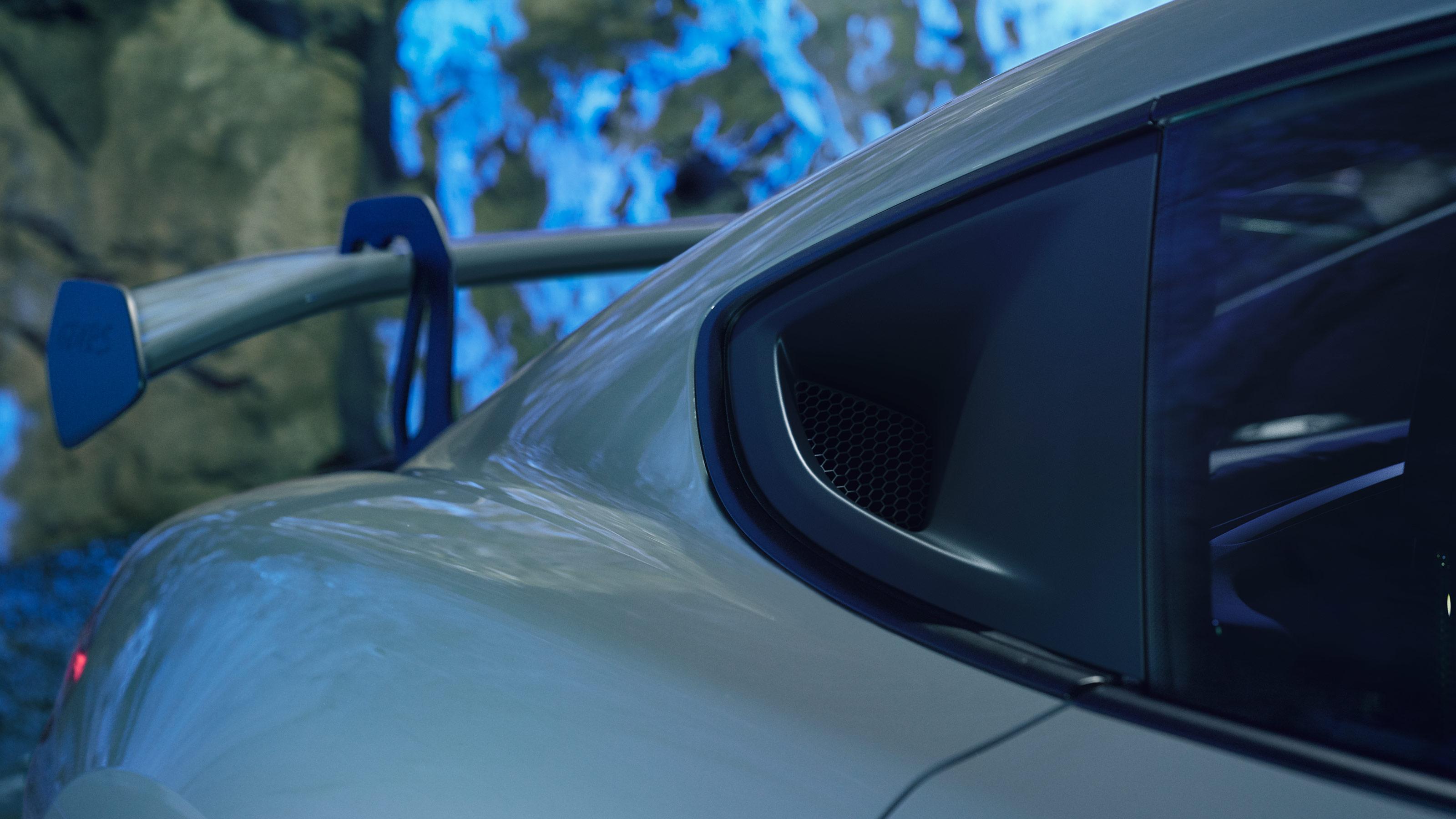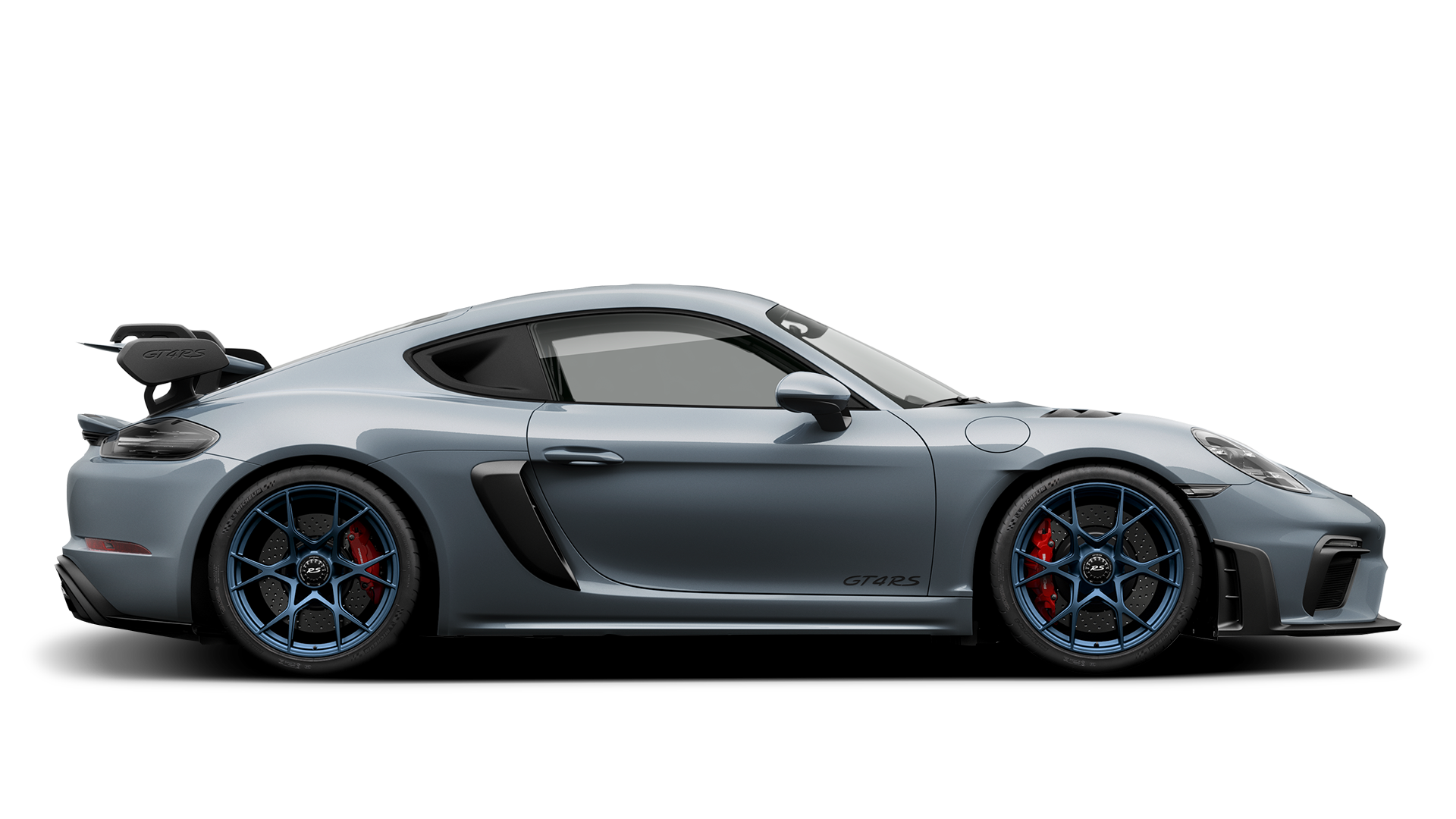
Perfectly irrational.
718 Cayman GT4 RS (WLTP)*
13,0
л/100 км
295
г/км
A razor-sharp track tool. A highly agile mid-engine concept with 4.0-litre displacement and a six-cylinder naturally aspirated engine. Six individual throttle valves for a direct response. A high-revving concept that easily scratches the 9,000 mark. An output of 368kW (500PS). Rational? Not always. Perfect? Always.
Vehicle shown with Weissach package and other optional equipment.
Bonnet with NACA air intakes for optimum brake cooling.
Louvres in the CFRP wings for improved wheel arch ventilation.
Rear wing with swan-neck connection for increased downforce.
360° Exterior.

Developed in Flacht, at home on the open road: the 4.0-litre six-cylinder horizontally opposed naturally aspirated engine with six individual throttle valves.
718 Cayman GT4 RS (WLTP)*
13,0
л/100 км
295
г/км

Visible engine technology: the airbox has been moved to the interior and features a newly developed air filter for a throaty interior sound and optimum air flow.

Purist sound with a motorsport character.

Tested on the rig and the track: the Weissach package with the characteristic use of a carbon-weave finish.

7-speed Porsche Doppelkupplung (PDK) with a new PDK gear selector that looks like a manual gear lever, for sporty, succinct gear changes.

Motorsport feeling: the cockpit.
At its centre: the GT4 RS-specific Sports steering wheel with yellow top centre marking and black gearshift paddles with yellow markings, allowing short, succinct gear changes as in motorsport.
360° Interior.
The highlights of the 718 Cayman GT4 RS.
Would you like to complete an extra lap in the 718

Aerodynamics and design
Exterior and lightweight concept.
open chapterPerformance
Chassis, brakes and Sport Chrono Package.
open chapterInterior and infotainment
Cockpit, seats and the
Motorsport
The 718

Aerodynamics and design
Performance
Interior and infotainment
Motorsport
Configure 718 Cayman GT4 RS model.
718 Cayman GT4 RS
333 000,00 BGN c ДДС
Price
368 кВт/500 к.с.
Мощност (кВт)/Мощност (к.с.)
3,4 s
Ускорение 0 - 100 км/ч
315 км/ч
Максимална скорост
WLTP*
13,0
л/100 км
295
г/км
Височина
1 267 мм
Широчина
1 822 мм
Дължина
4 456 мм
Междуосие
2 482 мм
Technical Specs
| Брой цилиндри | 6 Брой |
| Диаметър на цилиндър | 102,0 мм |
| Ход на бутало | 81,5 mm |
| Работен обем | 3 996 cm³ |
| Мощност (кВт) | 368 кВт |
| Мощност (к.с.) | 500 к.с. |
| Точка об./мин на максимална мощност | 8 400 об./мин |
| Максимални обороти на двигателя | 9 000 об./мин |
| Макс. въртящ момент | 450 Nm |
| Томка об./мин на максимален въртящ момент | 6 750 об./мин |
| Максимална литрова мощност (кВт/л) | 92,00 кВт/л |
| Максимална литрова мощност (к.с./л) | 125,00 кВт/л |
| Максимална скорост | 315 км/ч |
| Ускорение 0 - 100 км/ч | 3,4 s |
| Ускорение 0 - 160 км/ч | 7,1 s |
| Ускорение 0 - 200 км/ч | 10,9 s |
| Ускорение на предавка (80-120 км/ч) (50-75 mph) | 1,9 s |
| Дължина | 4 456 мм |
| Широчина | 1 822 мм |
| Ширина (и огледалата) | 1 994 мм |
| Височина | 1 267 мм |
| Междуосие | 2 482 мм |
| Радиус на завой | 11,4 м |
| Тегло без товар (DIN) | 1 415 кг |
| Тегло без товар (EU) | 1 490 кг |
| Допустимо бруто тегло | 1 771 кг |
| Максимален товар | 356 кг |
| Обем на багажното отделение, предно | 125 л |
| Отворен обем на багажното отделение (зад предните седалки) | 136 л |
| Разход на гориво градски | 21,8 - 21,8 л/100 км |
| Разход на гориво крайградски | 12,1 - 12,1 л/100 км |
| Разход на гориво извънградски | 11,0 - 11,0 л/100 км |
| Разход на гориво магистрала | 11,9 - 11,9 л/100 км |
| Разход на гориво комбиниран | 13,0 - 13,0 л/100 км |
| Емисии на CO2 ниска (скор.) (WLTP) | 495 - 495 г/км |
| Емисии на CO2 средна (скор.) (WLTP) | 275 - 275 г/км |
| Емисии на CO2 висока (скор.)(WLTP) | 250 - 250 г/км |
| Емисии на CO2 свръхвисока (скор.) (WLTP) | 271 - 271 г/км |
| Емисии на CO2 комбинирани (WLTP) | 295 - 295 г/км |
| Звуково ниво на стационарен автомобил | 96 дБ(A) |
| Звуково ниво на стационарен автомобил (об./мин) | 3 800 об./мин |
| Звуково ниво на преминаващ автомобил | 72 дБ(A) |
| PDK | 333 000,00 BGN c ДДС |
Gallery.
718 Cayman GT4 RS
718 Cayman GT4 RS
718 Cayman GT4 RS
718 Cayman GT4 RS
718 Cayman GT4 RS
718 Cayman GT4 RS
718 Cayman GT4 RS
718 Cayman GT4 RS
718 Cayman GT4 RS
718 Cayman GT4 RS
718 Cayman GT4 RS
718 Cayman GT4 RS
718 Cayman GT4 RS
718 Cayman GT4 RS
718 Cayman GT4 RS
718 Cayman GT4 RS
718 Cayman GT4 RS
718 Cayman GT4 RS
718 Cayman GT4 RS
718 Cayman GT4 RS
718 Cayman GT4 RS
718 Cayman GT4 RS

The track tool for your wrist.
The Porsche Design Chronograph 718 Cayman GT4 RS has plenty of performance character, extending the lightweight concept to your wrist. Also available with optional Weissach package. Exclusive ly for 718 Cayman GT4 RS owners.
Jewel of the far north.
Roads and wilderness like some mythical land. Corners that disappear into the vastness of green meadows. Charming villages, spectacular cliffs and spellbinding views. Untamed, not a soul in sight, and, perhaps for that very reason, rich in impressions. Start your trip with ROADS and explore the stunning landscape of the Faroe Islands.


Personalisation & finishing.
In the




































































